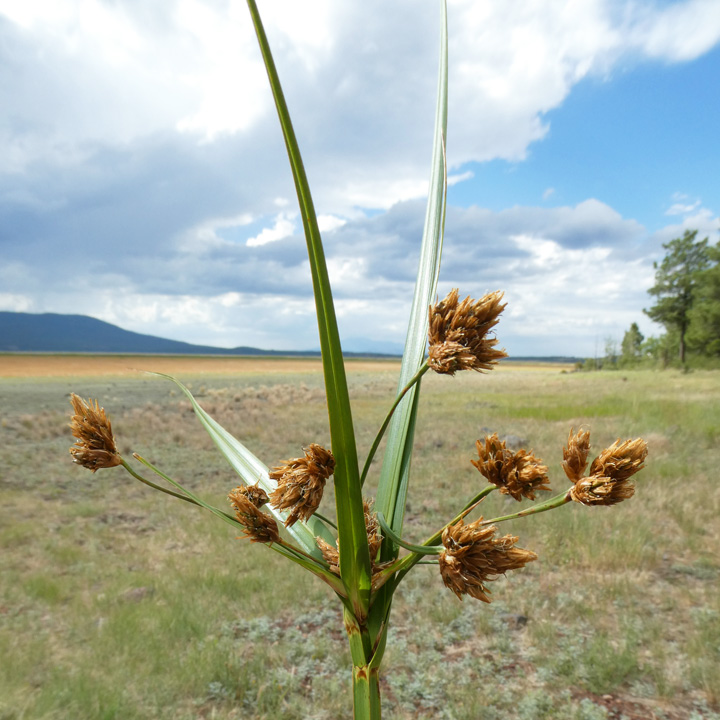
|
Family: Cyperaceae |
Herbs, perennial, cespitose or not, rhizomatous. Culms solitary or not, cormose at base [except eastern Asian Bolboschoenus planiculmis (F. Schmidt) T. V. Egerova], sharply trigonous. Leaves basal and cauline; sheaths tubular; ligules absent; blades flat or V-shaped in cross section, prominently keeled on abaxial surface, distally trigonous. Inflorescences terminal, subumbellate, subcorymbose, or capitate; spikelets to 80, mostly 4-10 mm diam.; involucral bracts surpassing inflorescence 1-5, spreading or proximal erect, leaflike. Spikelets: scales 25 or more, spirally arranged, each subtending flower, abaxially puberulent, often glabrescent, tip notched and awned. Flowers bisexual; perianth of 3-6 bristles, straight or curved, shorter to slightly longer than achene, retrorsely spinulose; stamens 3; styles linear, 2-3-fid, base persistent. Achenes biconvex to trigonous, 2.3-5.5 mm, smooth. Bolboschoenus comprises at least six to as many as fifteen species, depending on the treatments of the B. maritimus and B. fluviatilis complexes and taxa of probable hybrid origin (J. Browning et al. 1995). Treatments of the genus published prior to J. Browning and K. D. Gordon-Gray (1993) and J. Browning et al. (1995) are unsatisfactory because of reliance on highly variable, nondiagnostic characters. The pericarp anatomy of the achene and the persistence of perianth bristles on shed achenes provide especially critical but seldom-used taxonomic characters. Detailed revisions utilizing these characters have been undertaken only in a few areas of the world, leaving many problems that cannot be resolved until a worldwide revision is completed. Pericarp anatomy is easily observed by examining hand-sections with a dissecting microscope. Achenes of the halophytic species B. maritimus and B. robustus have caducous bristles, and exocarp (epidermal) cells are lighter than water, greatly enlarged, and air-filled so that the achenes float for many days. In contrast, in the freshwater species B. fluviatilis and B. glaucus the bristles remain attached to the achenes and exocarp cells are very small; the achenes are denser than water and quickly sink (J. Browning et al. 1995). Bolboschoenus is further usually characterized by culms that are often distally scabrous or papillose on margins, and leaf blades that are antrorsely spinulose or papillose on margins and often abaxially on midribs. Those characteristics, in addition to the presence of durable corms at culm bases, noded culms (i.e., some leaves cauline), the complete absence of ligules, the abaxially keeled leaf blades, and puberulent spikelet scales that are apically 2-fid and prominently awned are diagnostic of all species worldwide except the eastern Asian B. planiculmis (F. Schmidt) T. V. Egorova. In recent years upon the dismemberment of Scirpus in the broad sense, the preponderance of evidence supports the recognition of Bolboschoenus as distinct from Schoenoplectus (C. D. Adams 1994c; J. Browning and K. D. Gordon-Gray 1993; J. Browning et al. 1995; J. J. Bruhl 1995; P. Goetghebeur and D. A. Simpson 1991; E. Hayasaka and H. Ohashi 2002; Z. Hroudová et al. 1998; T. Koyama 1980; A. A. Oteng-Yeboah 1974b). Bolboschoenus was included within Schoenoplectus by K. A. Lye (1971) on the basis of similarities in embryo morphology and by M. T. Strong (1993) on the basis of similarities in embryo, leaf, and inflorescence morphology, as well as the intermediate structure of the eastern Asian B. planiculmis. The similarities between Bolboschoenus and Schoenoplectus in leaves and inflorescences as pointed out by M. T. Strong (1993) appear to be superficial; and they do not include other features usually characteristic of Bolboschoenus as given above. Although B. planiculmis is similar to some species of Schoenoplectus in having all leaves basal, leaf blades trigonous, involucral bracts solitary and trigonous, and in lacking hard corms at the shoot bases, it clearly belongs to Bolboschoenus on the basis of the absence of ligules, as well as similarities in the achenes and floral scales. The vegetative morphology of B. planiculmis is probably an adaptaton to its highly aquatic, tidal habitat (T. Koyama 1980; E. Hayasaka and H. Ohashi 2002). In North America the following putative hybrids are known from regions of sympatry of the parental species: 1) Bolboschoenus maritimus × B. robustus, common along both Atlantic and Pacific coasts; 2) B. maritimus × B. glaucus, local in California and Idaho; 3) B. fluviatilis × B. robustus [= ×B. novae-angliae], uncommon on the Atlantic Coast; 4) B. fluviatilis × B. maritimus, uncommon and local in California. Putative hybrids are often sterile; achenes that are formed are often empty or contain abnormal embryos. Species of Bolboschoenus are often ecologically dominant in wetlands and are valuable food and habitat for wildlife (H. A. Kantrud 1996). Some species are cultivated in wildlife refuges in the United States and are important rice-field weeds in California. In this treatment, spikelet and floral scale measurements are for nonflattened structures and exclude awns; awn widths are often difficult to measure: floral scale apices frequently are so worn that the lobes are not evident and thus apices appear to taper into awns, and scales often split distally making it difficult to determine the position of the base of the awn; floral scale translucency is best determined with a dissecting microscope by placing a shiny needle beneath the scale; achene lengths include the beak and, if present, the persistent remnant of the style base; culm widths given herein are measured on the middle third of the culm; and inflorescence descriptions are for expanded inflorescenses.
|
This project was made possible in part by the Institute of Museum and Library Services [MG-70-19-0057-19].
Powered by Symbiota



